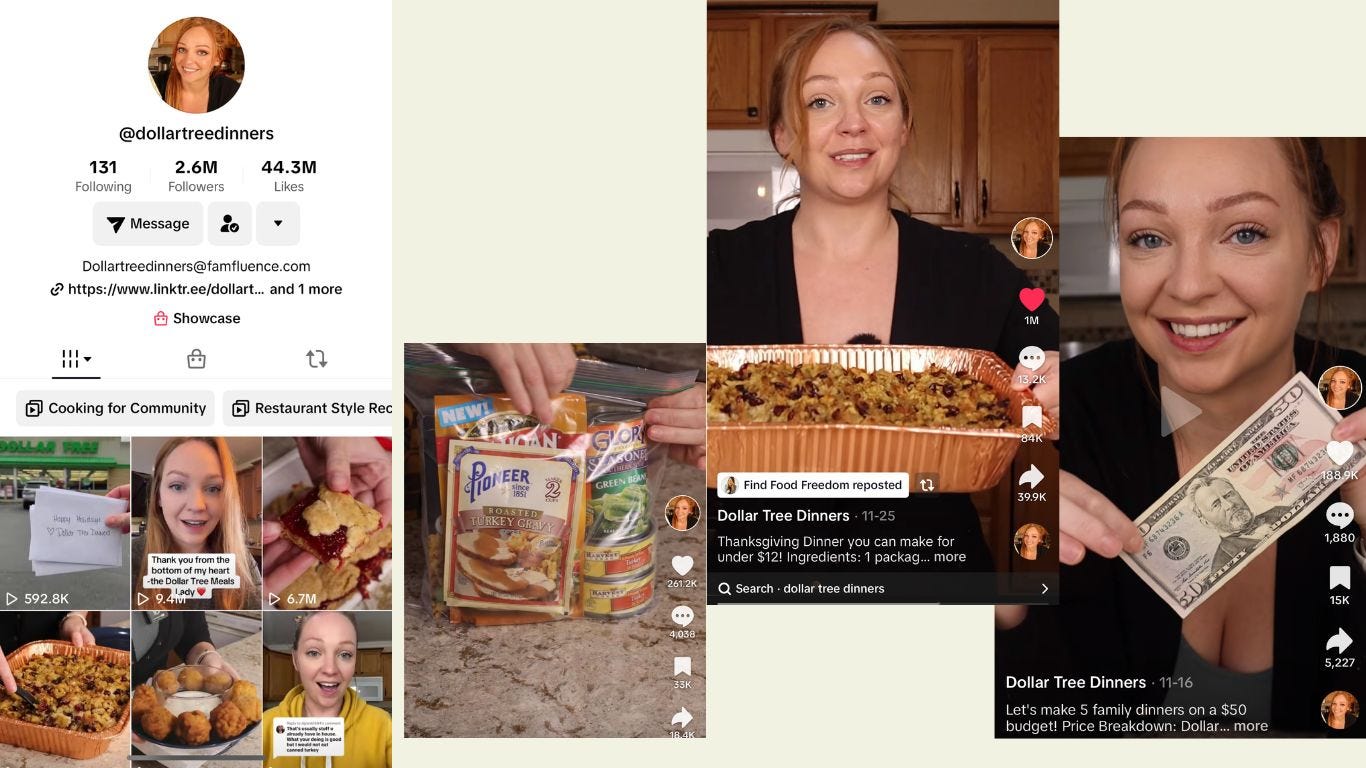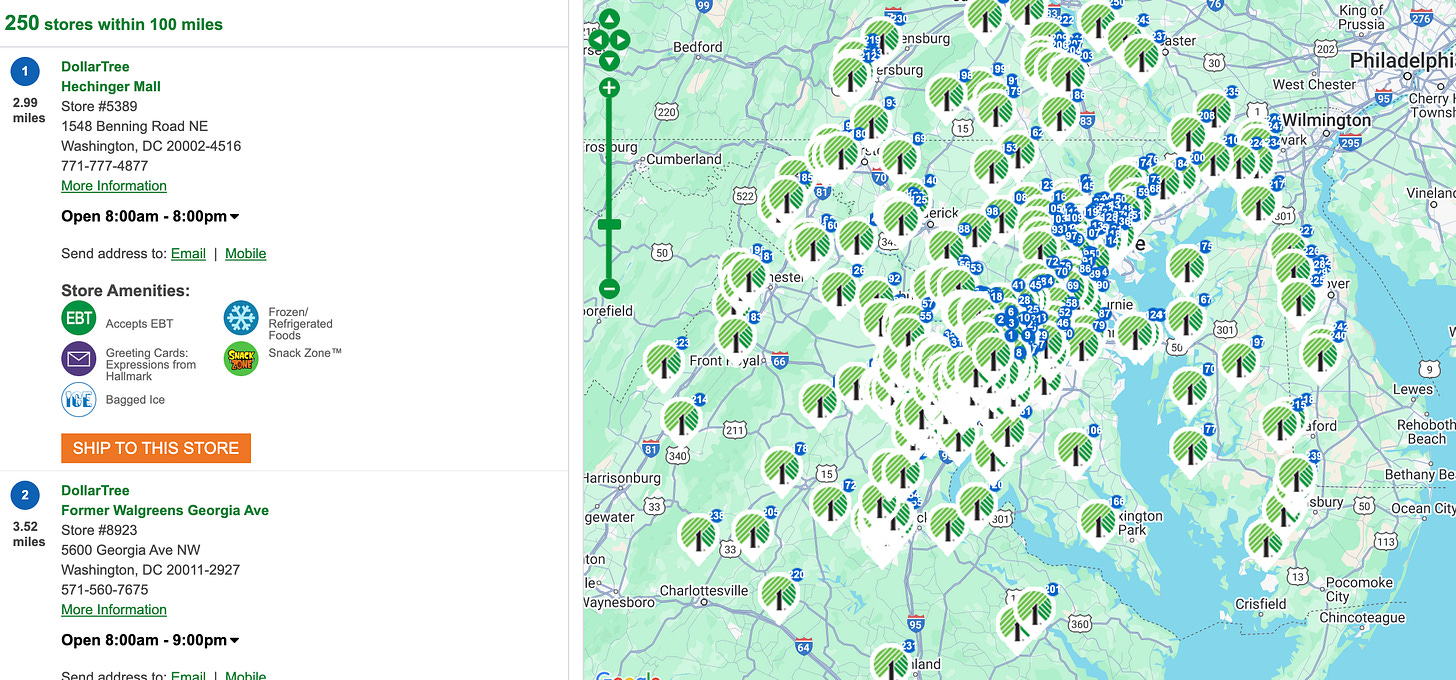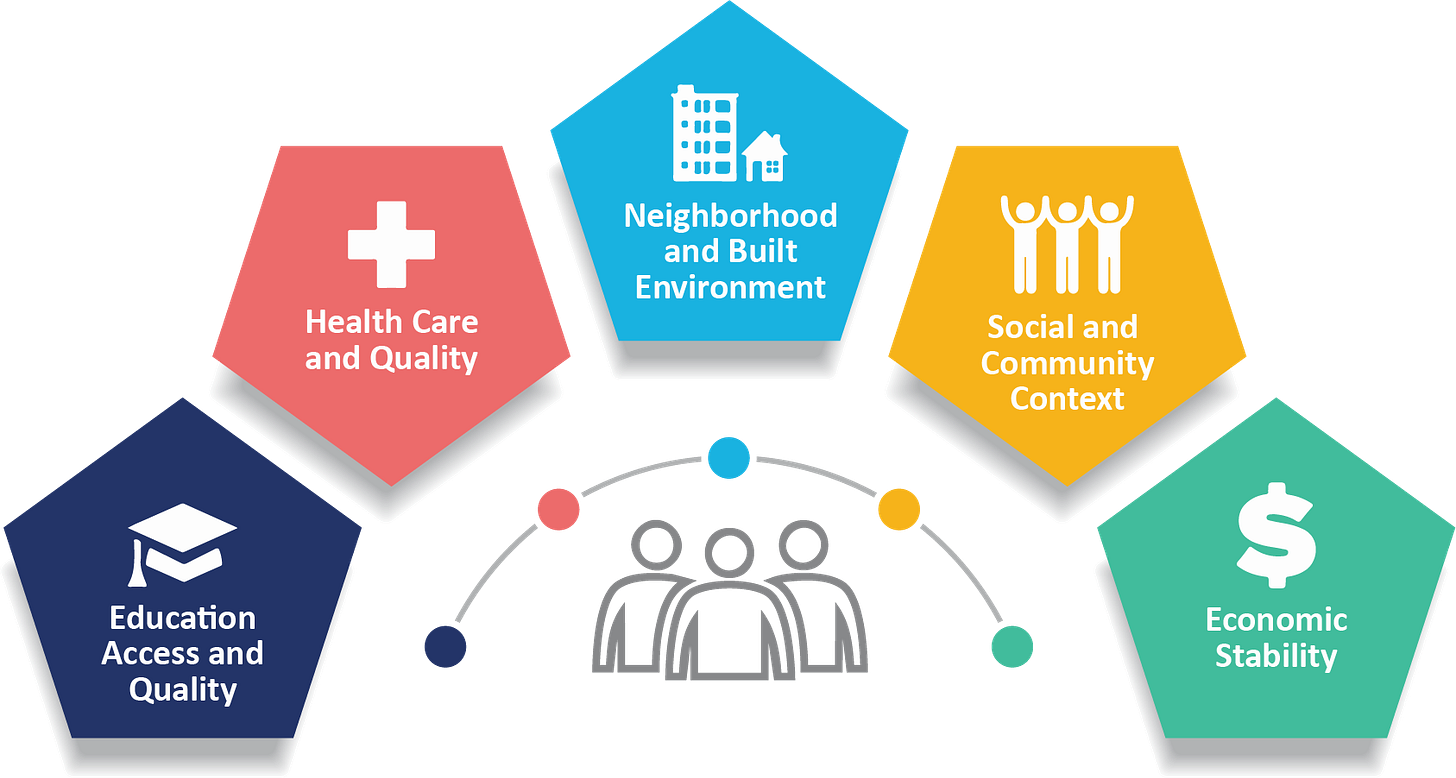Exploring Food Access Work as a Harm Reduction Practice
An essay on integrating harm reduction ideologies into food access work.
Back from a long hiatus as finals are now over, and I am a human again. I hope you enjoy this open letter/essay, I really enjoyed writing it! I’d love to hear your thoughts or feelings, and thanks again for reading! (p.s. all sources are at the end of the essay).
I saw a TikTok account over Thanksgiving break called “Dollartreedinners”, another TikToker had stitched one of this creator’s videos, and of course, I had to explore.
To my delight, the account “dollar tree dinners” focused on affordable and accessible recipes that were available at local discount stores (affectionately called dollar stores where I grew up). These were recipes that were full meals, not just quick snacks or convenience food, but meals that a whole family could enjoy.
The American Dollar Tree Phenomenon and Community Reach
For those who may not be familiar, the Dollar Tree is an American staple, or at least it is where I grew up (subtle PG County shoutout!).
I grew up making runs to and from the local “dollar stores” with my mother and my grandmother, and it felt like we went at least once or twice a week. Most items were pretty cheap, rarely over $20, and stores had a little bit of everything. Filled with generic brands of cleaning products, frozen and canned foods, and almost always Christmas decorations, no matter the time of year.
I think maybe that’s why this account struck me. I grew up getting food from Dollar Trees, frozen and canned. I remember vividly getting snacks with my grandma before going back to her apartment, it was just apart of our life, like any other grocery store would be.
What I didn’t quite realize at the time was how the accessibility of the Dollar Tree was filling a normally void space in the community and many communities like the one my grandma lived in. Urban to Suburban landscapes, usually low-income areas, with very few large grocery stores around.
As reported by the Dollar Tree corporate site, there are 15,500+ stores in 48 states and 5 Canadian provinces, which operate under different names such as Family Dollar and Dollar Tree Canada (1).
However, as I grew up, I realized how the Dollar Tree was often belittled, people turned their nose to it. Especially in the case of food access. This is where you may hear things like “just go to a grocery store” “people need to just eat fresh fruit and vegetables” “people are just lazy, they need to try harder”. I’ll be clear and say that these are all fallacies. False narratives that undermine the real food access issues in a multitude of communities in the United States.
We must ask ourselves: how can we look down on something, that is filling a food need? how can we listen, not judge, and work with what people have access to?
Dollar Tree Dinners, may be a great model on how to start.
Which brings me to the title of this newsletter, how can we incorporate harm reduction ideologies into food access work?
Defining Harm Reduction
For those unfamiliar with the term, “harm reduction” is defined by the Substance Abuse and Mental Health Services Administration (SAMHSA) as a “practical and transformative approach that incorporates community-driven public health strategies — including prevention, risk reduction, and health promotion — to empower people who use drugs (and their families) with the choice to live healthy, self-directed, and purpose-filled lives”(2).
This is not at all to equate eating certain foods to drug use, but to explain how viewing food access issues with a compassionate and a realistic lens in regards to the food landscape may prove to be a logical path forward.
This includes uplifting work that does not focus on shaming food choice, but instead, working with what people know, understand and have access to.
We cannot (we as in health care providers, dietitians, nutrition scientists, or anyone with an interest in nutrition) sit on our high horse and judge people’s food choices or belittle where people choose to get their food.
We do not live in a perfect society where everyone can buy locally, get fresh pressed juice, or even cook every meal for themselves. We must focus on supporting people through the infrastructure we DO have. And that includes dollar trees, corner stores, bodegas, and any other quick local stores. So I propose utilizing the three pillars SAMHSA mentions, prevention, risk reduction, and health promotion, and adjusting them towards a food access lens.
Prevention: “maintain and promote health, reduce risk factors, diagnose illnesses early, and prevent complications” (3)
Prevention in healthcare and food access is something that is often considered a “nice to have” vs. an absolute necessity. What I appreciate about the harm reduction space is the research, effort, and focus put on preventing drug abuse. There are several stages of prevention including primordial, primary, secondary, tertiary, and quaternary prevention, which all are different dependent upon stage of a disease. This is not meant to view lack of access to food as a disease, but rather help identify where to best intervene.
It allows for more nuance for food access work, since not everyone’s food landscape looks the same. For some communities, prevention may look like food education at local schools or community centers, for others it may look like working with city councils to address areas that don’t have transportation to grocery stores. For example, “dollar tree dinners” is an excellent example of a primary prevention technique. It’s filling the role of health education through cooking lessons online, empowering people with the tools they have, to eat whole, fulfilling meals.
Risk Reduction: “identifying medical, social and behavioral risks” to intervene and create better long term health outcomes (4)
Risk reduction is potentially the most directly aligned and connected to food access work. It is a term that is used in public health, drug prevention, and many other medical fields, as it can be life-altering when done well.
Risk reduction is inextricably linked to the SOCIAL DETERMINANTS OF HEALTH (capitalized for effect, but also because we all need to know about them and integrate them more). For the purpose of this essay, I will not be doing a deep dive of them, so please feel free to investigate that link, but know that reducing risk by addressing these determinants is an excellent way to start with food access work. This is harm reduction!!! This is harm reduction in food!!!
Let’s use the example of the social determinant, “economic stability”. It should come as no surprise, but households that fall beneath the poverty line are at the highest risk of food insecurity (6). This could be due to several issues, cheaper housing is often not close to grocery stores, grocery prices increasing, or just simply having other priorities that require money. So what does risk reduction look like when we are seeking to address economic stability and food access in communities?
At a more macro-level, this could look like supporting local, state, and federal policies and candidates that focus on increasing job growth, employment programs, and social safety nets. At a more micro and local level, this could look like working within your community to see what organizations are addressing unemployment or providing skills training. This all folds into risk reduction. The more time and effort we all put into addressing preventable risks for food access and food insecurity, the likelier we are to address the actual issue.
Health Promotion: “process of enabling people to increase control over, and to improve, their health” (7)
For all of my public health friends, I am sure this phrase haunts you lol. HOWEVER, it is still very relevant for food access work, and another tool to incorporate from the harm reduction framework. Why I really appreciate health promotion as an idea is because of its emphasis on the agency of a person. Something that is often ignored in food access work, and nutrition as a whole.
Paternalism is a term I often use in the case of food access work, and was perfectly framed in this article from Duke World Food Policy Center. Food access sees this concept more than others. In this article, it is defined as, “interfering in an individual’s or community’s ability or opportunity to choose and make decisions.” Food access often exudes a very paternalistic nature in this sense, and ignores the true meaning of health promotion. People should be able to make their own decisions on their health and the foods they eat.
Where we come in is by advocating for resources that allow for informed choice. This looks like advocating for more accessible and affordable food options in neighborhoods, this DOES NOT mean building a bunch of organic-based, expensive stores. This looks like creating community events to encourage learning about cooking and nutrition, this DOES NOT look like telling people their cultural foods and food stores are not “healthy”.
The entire idea of health promotion is simply to allow space and resources for tools to food access to be utilized. I often say, “you can lead a horse to water, but you cannot make it drink”, and I think that holds true to food access work. It is not our job to push what we deem as “healthy” food options onto communities, but it is our job to serve as a educational resource, advocate for nutrient-dense food options (affordability and accessibility), and support communities in whatever food landscape they exist in.
This leads me back to the initial impetus of this essay, Dollar Tree Dinners, a perfect example of meeting people where they are at instead of shaming them for things outside of their control.
After 4+ years of working and learning in the food access space, my excitement about content like this continues to grow, and leaves me hopeful for a more realistic approach to food access work. My hope is that people within this space, myself included, continue to listen to communities and their needs before casting judgment or prescribing a solve. “Harm reduction” is also about reducing stigma and fear, and that is what I hope this push towards affordable food solutions does.
The key to sustainable impact and change is always collaboration, and I hope we can all continue to discuss as the work continues.
Sources:
https://corporate.dollartree.com/investors/company-information
https://www.samhsa.gov/find-help/harm-reduction
https://pmc.ncbi.nlm.nih.gov/articles/PMC10350749/#:~:text=Primary%20prevention%20aims%20to%20prevent,families%2C%20communities%2C%20and%20countries.
https://pmc.ncbi.nlm.nih.gov/articles/PMC6685522/
https://odphp.health.gov/healthypeople/priority-areas/social-determinants-health
https://www.ers.usda.gov/data-products/ag-and-food-statistics-charting-the-essentials/food-security-and-nutrition-assistance/#:~:text=Food%20insecurity%20rates%20are%20highest,principal%20cities%20and%20rural%20areas.
https://www.who.int/westernpacific/about/how-we-work/programmes/health-promotion
https://wfpc.sanford.duke.edu/reports/identifying-and-countering-white-supremacy-culture-in-food-systems/#:~:text=Whiteness%20permeates%20the%20food%20system,create(s)%20inviting%20spaces%20for
https://www.cdc.gov/public-health-gateway/php/about/social-determinants-of-health.html






great framing! thanks for sharing this